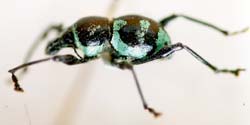Articles and reports from the Life Sciences and chemistry area deal with applied and basic research into modern biology, chemistry and human medicine.
Valuable information can be found on a range of life sciences fields including bacteriology, biochemistry, bionics, bioinformatics, biophysics, biotechnology, genetics, geobotany, human biology, marine biology, microbiology, molecular biology, cellular biology, zoology, bioinorganic chemistry, microchemistry and environmental chemistry.

New approaches yield gene-rich regions, accelerate sequencing
Decoding of a variety of plant genomes could accelerate due to two complementary methods that remove from analysis vast stretches of DNA that do not contain genes.
The approaches, applied jointly in efforts to determine the gene sequences in maize, are described in the Dec. 19 issue of the journal Science. The evaluation of these methods and the assembly of the resulting sequences were undertaken by two groups led

Humans are not alone in suffering the ravages of aging. Cockroaches endure it, too.
Case Western Reserve University researchers reported in the Journal of Experimental Biology that as the roach’s life wanes between 60-65 weeks after the onset of adulthood, and the cockroach slows down, experiences stiff joints and has problems climbing and a decreased spontaneous fleeing response. Death comes shortly after the onset of these movement problems.
Angela Ridgel, a post doc

The gemstone opal could be manufactured synthetically copying a technique employed by a beetle to control the appearance of its outer shell.
Researchers from the Department of Zoology at the University of Oxford have discovered the first case of opal in an animal, in this case in the weevil Pachyrhynchus argus, found in forests in north-eastern Queensland, Australia. This animal produces a photonic crystal structure analogous to that of opal, which gives it a relatively uniform, metallic co

International HapMap Project begins the cartography of human genome variation
Tracking down genes involved in health and disease and the response of patients to therapies is a principal goal of contemporary biomedical research. In the December 18 issue of Nature, the International HapMap Consortium describes the new tools and approaches it has developed that will enhance the ability of scientists to identify disease-related genes and to develop corresponding diagnostic and therapeutic

Many of our actions are guided by past experiences combined with insight into the future. A major mystery of biology involves understanding how brain cells can create a representation that extends backward and forward through time. A new study conducted by researchers at Mount Sinai School of Medicine published in the December 18th issue of Neuron begins to unravel the brain activity that underlies concurrent processing of the recent past, the present and the imminent future.
Memories that

A US$53-million international project to sequence the cattle genome, involving CSIRO, was launched today (1pm, Friday, 12 December US, 5am Saturday, 13 December AEST) in Washington, United States.
The joint sequencing effort is led by the US National Human Genome Research Institute (NHGRI), which is part of the National Institutes of Health (NIH), and also involves United States Department of Agriculture; the State of Texas; Genome Canada; and Agritech Investments Ltd, Dairy Insight Inc. and